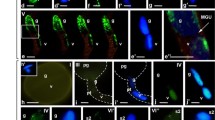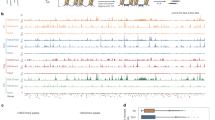Abstract
Histones are vital structural proteins of chromatin that influence its dynamics and function. The tissue-specific expression of histone variants has been shown to regulate the expression of specific genes and genomic stability in animal systems. Here we report on the characterization of five histone H3 variants expressed in Lilium generative cell. The gcH3 and leH3 variants show unique sequence diversity by lacking a conserved lysine residue at position 9 (H3K9). The gH3 shares conserved structural features with centromeric H3 of Arabidopsis. The gH3 variant gene is strongly expressed in generative cells and gH3 histone is incorporated in to generative cell chromatin. The lysine residue of H3 at position 4 (H3K4) is highly methylated in the nuclei of generative cells of mature pollen, while methylation of H3K4 is low in vegetative cell nuclei. Taken together, these results suggest that male gametic cells of Lilium have unique chromatin state and histone H3 variants and their methylation might be involved in gene regulation of male gametic cells.
Similar content being viewed by others
Abbreviations
- CenH3:
-
centromeric histone H3
- EST:
-
expressed sequence tag
- GC:
-
generative cell
- gcH3:
-
a generative cell histone variant reported by Xu et al. (1999a)
- gH3:
-
a generative cell histone variant reported by Ueda et al. (2000)
- H3K4:
-
Lys 4 residue of histone H3
- H3K4Me2 :
-
H3K4 dimethylation
- H3K9:
-
Lys 9 residue of histone H3
- H3K9Me2 :
-
H3K9 dimethylation
- DAPI:
-
4’,6-diamidino-2-phenylindole
References
Ahmad K, Henikoff S (2002) The histone variant H3.3 marks active chromatin by replication-independent nucleosome assembly. Mol Cell 9:1191–1200
Albig W, Ebentheuer J, Klobeck G, Kunz J, Doenecke D (1996) A solitary human H3 histone gene on chromosome 1. Hum Genet 97:486–491
Bramlage B, Kosciessa U, Doenecke D (1997) Differential expression of the murine histone genes H3.3A and H3.3B. Differentiation 62:13–20
Celeste A, Petersen S, Romanienko PJ, Fernandez-Capetillo O, Chen HT, Sedelnikova OA, Reina-San-Martin B, Coppola V, Meffre E, Difilippantonio MJ, Redon C, Pilch DR, Olaru A, Eckhaus M, Camerini-Otero RD, Tessarollo L, Livak F, Manova K, Bonner WM, Nussenzweig MC, Nussenzweig A (2002) Genomic instability in mice lacking histone H2AX. Science 296:922–927
Chaubet N, Clement B, Gigot C (1992) Genes encoding a histone H3.3-like variant in Arabidopsis contain intervening sequences. J Mol Biol 225:569–574
Engel ML, Chaboud A, Dumas C, McCormick S (2003) Sperm cells of Zea mays have a complex complement of mRNAs. Plant J 34:697–707
Frank D, Doenecke D, Albig W (2003) Differential expression of human replacement and cell cycle dependent H3 histone genes. Gene 312:135–143
Fernandez-Capetillo O, Mahadevaiah SK, Celeste A, Romanienko PJ, Camerini-Otero RD, Bonner WM, Manova K, Burgoyne P, Nussenzweig A (2003) H2AX is required for chromatin remodeling and inactivation of sex chromosomes in male mouse meiosis. Dev Cell 4:497–508
Grewal S, Moazed D (2003) Heterochromatin and epigenetic control of gene expression. Science 301:798–802
Grimes SR, Wolfe SA, Anderson JV, Stein GS, Stein JL (1990) Structural and functional analysis of the rat testis-specific histone H1t gene. J Cell Biochem 44:1–17
Hake SB, Xiao A, Allis CD (2004) Linking the epigenetic ‘language’ of covalent histone modifications to cancer. Brit J Cancer 90:761–769
Haerizadeh F, Singh MB, Bhalla PL (2006) Transcriptional repression distinguishes somatic from germ cell lineages in a plant. Science (in press)
Henikoff S, Ahmad K (2005) Assembly of variant histones into chromatin. Annu Rev Cell Dev Biol 21:133–153
Henikoff S, Ahmad K, Platero JS, van Steensel B (2000) Heterochromatic deposition of centromeric histone H3-like proteins. Proc Natl Acad Sci USA 97:716–721
Jin J, Cai Y, Li B, Conaway RC, Workman JL, Conaway JW, Kusch T (2005) In and out: histone variant exchange in chromatin. Trends Biochem Sci 30:680–687
Kaumeyer JF, Weinberg ES (1986) Sequence, organization and expression of late embryonic H3 and H4 histone genes from the sea urchin, Strongylocentrotus purpuratus. Nucleic Acids Res 14:4557–4576
Lim K, Chae CB (1992) Presence of a repressor protein for testis-specific H2B (TH2B) histone gene in early stages of spermatogenesis. J Biol Chem 267:15271–15273
Malik HS, Henikoff S (2003) Phylogenomics of the nucleosome. Nat Struct Biol 10:882–891
McKittrick E, Gafken PR, Ahmad K, Henikoff S (2004) Histone H3.3 is enriched in covalent modifications associated with active chromatin. Proc Natl Acad Sci USA 101:1525–1530
Okada T, Endo M, Singh MB, Bhalla PL (2005) Analysis of histone H3 gene family in Arabidopsis and identification of male gamete-specific variant, AtMGH3. Plant J 44:557– 568
Okada T, Sasaki Y, Ohta R, Onozuka N, Toriyama K (2000) Expression of Bra r 1 gene in transgenic tobacco and Bra r 1 promoter activity in pollen of various plant species. Plant Cell Physiol 41:757–766
Okada T, Bhalla PL, Singh MB (2006) Expressed sequence tag analysis of lilium longiflorum generative cells. Plant Cell Physiol 47:698–705
Pusarla RH, Bhargava P (2005) Histones in functional diversification—Core histone variants. FEBS J 272:5149–5168
Richards EJ, Elgin SCR (2002) Epigenetic codes for heterochromatin formation and silencing: Rounding up the usual suspects. Cell 108:489–500
Sambrook J, Russell DW, Sambrook J (2001) Molecular cloning: a laboratory manual. Cold Spring Harbor Laboratory Press, New York
Schumperli D (1986) Cell-cycle regulation of histone gene-expression. Cell 45:471–472
Sims RJ 3rd, Nishioka K, Reinberg D (2003) Histone lysine methylation: a signature for chromatin function. Trends Genet 19:629–639
Strahl BD, Allis CD (2000) The language of covalent histone modifications. Nature 403:41–45
Talbert PB, Masuelli R, Tyagi AP, Comai L, Henikoff S (2002) Centromeric localization and adaptive evolution of an Arabidopsis histone H3 variant. Plant Cell 14:1053– 1066
Ueda K, Kinoshita Y, Xu Z, Ide N, Ono M, Akahori Y, Tanaka I, Inoue M (2000) Unusual core histones specifically expressed in male gametic cells of Lilium longiflorum. Chromosoma 108:491–500
Ueda K, Tanaka I (1995) The appearance of male gamete-specific histones gH2B and gH3 during pollen development in Lilium longiflorum. Dev Biol 169:210–217
Witt O, Albig W, Doenecke D (1996) Testis-specific expression of a novel human H3 histone gene. Exp Cell Res 229:301–306
Xu H, Swoboda I, Bhalla PL, Singh MB (1999a) Male gametic cell-specific expression of H2A and H3 histone genes. Plant Mol Biol 39:607–614
Xu H, Swoboda I, Bhalla PL, Singh MB (1999b) Male gametic cell-specific gene expression in flowering plants. Proc Natl Acad Sci USA 96:2554–2558
Zalensky AO, Siino JS, Gineitis AA, Zalenskaya IA, Tomilin NV, Yau P, Bradbury EM (2002) Human testis/sperm-specific histone H2B (hTSH2B)—Molecular cloning and characterization. J Biol Chem 277:43474–43480
Zweidler A (1984) Core histone variants of the mouse: primary structure and differential expression. In: Stein GS, Stein JL, Marzluff WF (eds) Histone genes: structure, organization and regulation. John Wiley and Sons, New York, pp. 339–371
Acknowledgement
We gratefully acknowledge financial support provided by the Australian Research Council (ARC) for this project.
Author information
Authors and Affiliations
Corresponding author
Additional information
Accession numbers for the sequence data
The sequences reported in this paper have been deposited in the DDBJ database gcH3 GC1174 (accession no. AB195644), gH3 GC1008 (accession no. AB195646), leH3 GC1126 (accession no. AB195648), soH3-1 GC0075 (accession no. AB195650), soH3-2 GC1661 (accession no. AB195652), genomic sequence of gcH3 (accession no. AB195645), genomic sequence of gH3 (accession no. AB195647), genomic sequence of leH3 (accession no. AB195649), genomic sequence of soH3-2 (accession no. AB195651), genomic sequence of soH3-2 (accession no. AB195653).
Rights and permissions
About this article
Cite this article
Okada, T., Singh, M.B. & Bhalla, P.L. Histone H3 variants in male gametic cells of lily and H3 methylation in mature pollen. Plant Mol Biol 62, 503–512 (2006). https://doi.org/10.1007/s11103-006-9036-8
Received:
Accepted:
Published:
Issue Date:
DOI: https://doi.org/10.1007/s11103-006-9036-8




